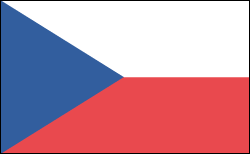CZECH REPUBLIC

Geography: The Czech Republic's central European landscape is dominated by the Bohemian Massif, which rises to heights of 3,000 ft (900 m) above sea level. This ring of mountains encircles a large elevated basin, the Bohemian Plateau. The principal rivers are the Elbe and the Vltava.
Government: Parliamentary democracy.
History: Probably about the 5th century A.D. , Slavic tribes from the Vistula basin settled in the region of Bohemia, Moravia, and Silesia. The Czechs founded the kingdom of Bohemia and the Premyslide dynasty, which ruled Bohemia and Moravia from the 10th to the 16th century. One of the Bohemian kings, Charles IV, Holy Roman Emperor, made Prague an imperial capital and a center of Latin scholarship. The Hussite movement founded by Jan Hus (1369?–1415) linked the Slavs to the Reformation and revived Czech nationalism, previously under German domination. A Hapsburg, Ferdinand I, ascended the throne in 1526. The Czechs rebelled in 1618, precipitating the Thirty Years' War (1618–1648). Defeated in 1620, they were ruled for the next 300 years as part of the Austrian empire. Full independence from the Hapsburgs was not achieved until the end of World War I, following the collapse of the Austrian-Hungarian Empire.
A union of the Czech lands and Slovakia was proclaimed in Prague on Nov. 14, 1918, and the Czech nation became one of the two component parts of the newly formed Czechoslovakian state. In March 1939, German troops occupied Czechoslovakia, and Czech Bohemia and Moravia became German protectorates for the duration of World War II. The former government returned in April 1945 when the war ended and the country's pre-1938 boundaries were restored. When elections were held in 1946, Communists became the dominant political party and gained control of the Czechoslovakian government in 1948. Thereafter, the former democracy was turned into a Soviet-style state.
Nearly 42 years of Communist rule ended with the nearly bloodless “velvet revolution” in 1989. Václav Havel, a leading playwright and dissident, was elected president of Czechoslovakia in 1989. Havel, imprisoned twice by the Communist regime and his plays banned, became an international symbol for human rights, democracy, and peaceful dissent. The return of democratic political reform saw a strong Slovak nationalist movement emerge by the end of 1991, which sought independence for Slovakia. When the general elections of June 1992 failed to resolve the continuing coexistence of the two republics within the federation, Czech and Slovak political leaders agreed to separate their states into two fully independent nations. On Jan. 1, 1993, the Czechoslovakian federation was dissolved and two separate independent countries were established—the Czech Republic and Slovakia. The Czech Republic joined NATO in March 1999.
In Aug. 2002, severe flooding caused 70,000 people in Prague and 200,000 nationwide to be evacuated.

Map of Czech
Republic
President: Milos Zeman (2013)
Prime Minister: Bohuslav Sobotka
(2014)
Land area: 29,836 sq mi (77,276 sq km);
total area: 30,450 sq mi (78,866 sq km)
Population (2014 est.): 10,627,448
(growth rate: 0.17%); birth rate: 9.79/1000; infant mortality rate:
2.63/1000; life expectancy: 78.31
Capital and largest city (2011 est.):
Prague, 1.276 million
Other large cities: Brno, 376,400;
Ostrava, 317,700; Plzen, 164,900; Olomouc, 102,900
Monetary unit: Koruna
National name: Ceska Republika
Language:
Czech 95.4%, Slovak 1.6%, other 3% (2011 census)
Ethnicity/race:
Roman Catholic 10.4%, Protestant (includes Czech Brethren and Hussite) 1.1%, other and unspecified 54%, none 34.5% (2011 est.)
National Holiday:
Czech Founding Day, October 28
Religions:
Roman Catholic 27%, Protestant 2%,
unaffiliated 59% (2001)
Literacy rate: 99% (2011 est.)
Economic summary: GDP/PPP (2013
est.): $194.8 billion; per capita $26,300. Real growth rate:
–0.9%. Inflation: 1.4%. Unemployment: 7.1%. Arable
land: 40.12%. Agriculture: wheat, potatoes, sugar beets,
hops, fruit; pigs, poultry. Labor force: 5.304 million;
agriculture 2.6%, industry 37.4%, services 60% (2012 est.).
Industries: metallurgy, machinery and equipment, motor vehicles,
glass, armaments. Natural resources: hard coal, soft coal,
kaolin, clay, graphite, timber. Exports: $161.4 billion
(2013 est.): machinery and transport equipment, chemicals,
raw materials and fuel. Imports: $143.4 billion
(2013 est.): machinery and transport equipment, raw
materials and fuels, chemicals. Major trading
partners: Germany, Slovakia, Austria, Poland, UK, France,
Netherlands, China, Russia (2012).
Communications: Telephones: main lines
in use: 2.1 million (2012); mobile cellular: 12.973 million (2012).
Broadcast media: roughly 130 TV broadcasters
operating some 350 channels with 4 publicly operated and the remainder
in private hands; 16 TV stations have national coverage with 4 being
publicly operated; cable and satellite TV subscription services are
available; 63 radio broadcasters are registered operating roughly 80
radio stations with 15 stations publicly operated; 10 radio stations
provide national coverage with the remainder local or regional (2008). Internet hosts: 4.148 million (2012). Internet
users: 6.681 million (2009).
Transportation: Railways: total: 9,469
km (2008). Roadways: total: 130,671 km; (2010).
Waterways: 664 km (on Elbe, Vltava, and Oder rivers) (2010).
Ports and harbors: Decin, Prague, Usti nad Labem.
Airports: 128 (2013).
International disputes: while
threats of international legal action never materialized in 2007,
915,220 Austrians, with the support of the popular Freedom Party, signed
a petition in January 2008, demanding that Austria block the Czech
Republic's accession to the EU unless Prague closes its controversial
Soviet-style nuclear plant in Temelin, bordering Austria.
-------------------- o --------------------
No comments:
Post a Comment